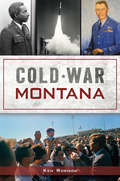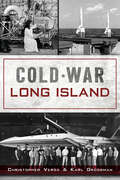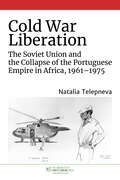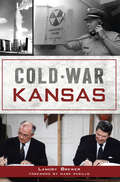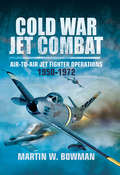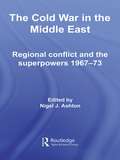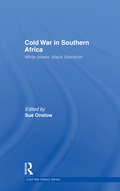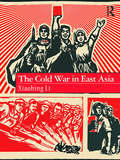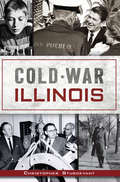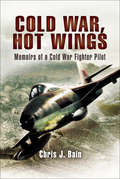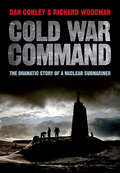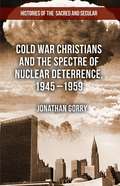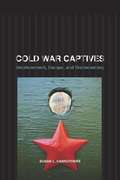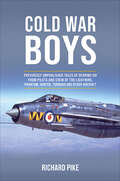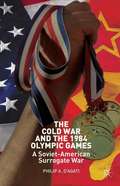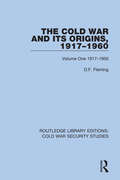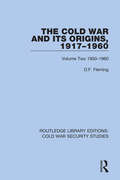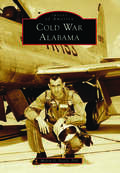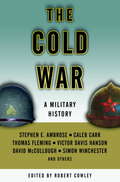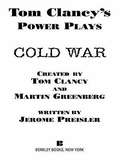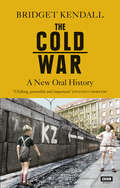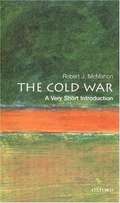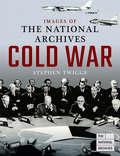- Table View
- List View
Cold War Montana (Military)
by Ken RobisonHome to some of the most powerful nuclear missile systems in the world, Montana played an indispensable role in the war against Communism. Utilizing the Lend-Lease pipeline, Soviet spies ferried stolen nuclear and industrial secrets, loaded in diplomatic pouches, from Great Falls to the Soviet Union. Army nurse Lieutenant Diane Carlson served as "an angel of mercy" at the Pleiku Evacuation Hospital in the Central Highlands in Vietnam. Young Montana smokejumper "Hog" Daniels joined the CIA's secret war in Southeast Asia, becoming the principal advisor to General Vang Pao in his desperate fight against Communists. Captain Ken Robison (U.S. Navy, Ret.), award-winning author and Cold Warrior, reveals tales of Montanans who made their mark on this titanic struggle.
Cold War Long Island (Military)
by Christopher Verga Karl GrossmanBy the close of World War II, Long Island had transformed from a rural corridor to a suburban behemoth. The region became a nationally recognized manufacturing and innovation hub for the military and possessed one of the fastest-growing middle-class populations in the country. But behind the manicured lawns and cookie-cutter cape homes, locals were adapting to new Cold War conflicts and facing anxieties of a potential nuclear fallout. Secret nuclear missile sites and classified government laboratories were established on the outskirts of Suffolk County, often among unaware residents. Soviet spy rings traversed across the island, seeking to steal industry secrets and monitor military installations. Author Christopher Verga and veteran journalist Karl Grossman bring to life the often overlooked history of the Cold War era in Nassau and Suffolk Counties.
Cold War Liberation: The Soviet Union and the Collapse of the Portuguese Empire in Africa, 1961–1975 (New Cold War History)
by Natalia TelepnevaCold War Liberation examines the African revolutionaries who led armed struggles in three Portuguese colonies—Angola, Mozambique, and Guinea-Bissau—and their liaisons in Moscow, Prague, East Berlin, and Sofia. By reconstructing a multidimensional story that focuses on both the impact of the Soviet Union on the end of the Portuguese Empire in Africa and the effect of the anticolonial struggles on the Soviet Union, Natalia Telepneva bridges the gap between the narratives of individual anticolonial movements and those of superpower rivalry in sub-Saharan Africa during the Cold War. Drawing on newly available archival sources from Russia and Eastern Europe and interviews with key participants, Telepneva emphasizes the agency of African liberation leaders who enlisted the superpower into their movements via their relationships with middle-ranking members of the Soviet bureaucracy. These administrators had considerable scope to shape policies in the Portuguese colonies which in turn increased the Soviet commitment to decolonization in the wider region. An innovative reinterpretation of the relationships forged between African revolutionaries and the countries of the Warsaw Pact, Cold War Liberation is a bold addition to debates about policy-making in the Global South during the Cold War. We are proud to offer this book in our usual print and ebook formats, plus as an open-access edition available through the Sustainable History Monograph Project.
Cold War Kansas (Military)
by Landry BrewerKansas played an outsized role in the Cold War, when civilization's survival hung in the balance. Forbes Air Force Base operated nine Atlas E intercontinental ballistic missile launch sites. Schilling Air Force Base was the hub for twelve Atlas F ICBMs. McConnell Air Force Base operated eighteen Titan II ICBMs. A Kansas State University engineering professor converted a discarded Union Pacific Railroad water tank into his family's backyard fallout shelter. A United States president from Kansas faced several nuclear war scares as the Cold War moved into the thermonuclear age. Landry Brewer tells the fascinating story of highest-level national strategy and how everyday Kansans lived with threats to their way of life.
Cold War Jet Combat: Air-to-Air Jet Fighter Operations, 1950–1972
by Martin W. BowmanRecounted here are nine of the earliest wars involving jet aircraft. From the Korean War and beyond, it comprises a wealth of gripping insight. Many of the jet-to-jet dogfights that spanned these jet-powered wars are enlivened to thrilling effect, including those engaged in during the two Indo-Pak Wars of 1965 and 1971. Operation Musketeer (1956), mounted when RAF and French Air Force bombers and fighter-bombers attacked airfields and other targets in Egypt (after President Nasser had nationalised the Suez Canal), is also covered in this gripping narrative. The Falklands Campaign is also covered, as is the Vietnam War. In another chapter, QRA operations around the British Isles are put under the microscope as RAF Phantoms, Lightnings, Tornadoes and Typhoon Eurofighters on Quick Reaction Alert are described, patrolling international air space and maintaining a constant vigil as Soviet Bears continued to test NATO defences. All in all, this is a compelling, well-researched and highly informative study of a particularly dynamic era in aviation history.
The Cold War in the Middle East: Regional Conflict and the Superpowers 1967-73 (Cold War History Ser.)
by Nigel J. AshtonThis edited volume re-assesses the relationship between the United States, the Soviet Union and key regional players in waging and halting conflict in the Middle East between 1967 and 1973. These were pivotal years in the Arab-Israeli conflict, with the effects still very much in evidence today. In addition to addressing established debates, the bo
Cold War in Southern Africa: White Power, Black Liberation (Cold War History)
by Sue OnslowThis edited volume examines the complexities of the Cold War in Southern Africa and uses a range of archives to develop a more detailed understanding of the impact of the Cold War environment upon the processes of political change. In the aftermath of European decolonization, the struggle between white minority governments and black liberation movements encouraged both sides to appeal for external support from the two superpower blocs. Cold War in Southern Africa highlights the importance of the global ideological environment on the perceptions and consequent behaviour of the white minority regimes, the Black Nationalist movements, and the newly independent African nationalist governments. Together, they underline the variety of archival sources on the history of Southern Africa in the Cold War and its growing importance in Cold War Studies. This volume brings together a series of essays by leading scholars based on a wide range of sources in the United States, Russia, Cuba, Britain, Zambia and South Africa. By focussing on a range of independent actors, these essays highlight the complexity of the conflict in Southern Africa: a battle of power blocs, of systems and ideas, which intersected with notions and practices of race and class This book will appeal to students of cold war studies, US foreign policy, African politics and International History. Sue Onslow has taught at the London School of Economics since 1994. She is currently a Cold War Studies Fellow in the Cold War Studies Centre/IDEAS
The Cold War in East Asia
by Xiaobing LiThis textbook provides a survey of East Asia during the Cold War from 1945 to 1991. Focusing on the persistence and flexibility of its culture and tradition when confronted by the West and the US, this book investigates how they intermesh to establish the nations that have entered the modern world. Through the use of newly declassified Communist sources, the narrative helps students form a better understanding of the origins and development of post-WWII East Asia. The analysis demonstrates how East Asia’s position in the Cold War was not peripheral but, in many key senses, central. The active role that East Asia played, ultimately, turned this main Cold War battlefield into a "buffer" between the United States and the Soviet Union. Covering a range of countries, this textbook explores numerous events, which took place in East Asia during the Cold War, including: The occupation of Japan, Civil war in China and the establishment of Taiwan, The Korean War, The Vietnam War, China’s Reforming Movement. Moving away from Euro-American centric approaches and illuminating the larger themes and patterns in the development of East Asian modernity, The Cold War in East Asia is an essential resource for students of Asian History, the Cold War and World History.
Cold War Illinois
by Christopher SturdevantFrom Walt Disney and Ronald Reagan to chess matches and Nike missiles, trace the Illinois roots of prominent players in the longest and costliest conflict in American history. Discover a mobster's involvement in assassination attempts of Cuban leader Fidel Castro and how the nuclear age began at a college football field on Chicago's south side. Visit the graves of Communist Party leaders and the high-alert heritage of military bases across the state. Local author Christopher Sturdevant, chairman of the Midwest Chapter of the Cold War Museum, follows up his look into Cold War Wisconsin with its neighbor to the south in a fascinating tale of Illinois's role in the fight between East and West.
Cold War, Hot Wings: Memoirs of a Cold War Fighter Pilot, 1962–1994
by Chris J. BainThis is a semi-autobiographical account of a fighter pilot in the RAF from 1962 to 1994. He was both a Hunter and Harrier pilot, rose to Squadron Leader level, and commanded fighter and strategic reconnaissance units. He was CO of the Desert Rescue Team, flew Dakotas on desert supply running, and saw active fighter service receiving bullet holes in his aircraft during the Aden Radfan campaign. He flew Cold War covert reconnaissance missions, commanded the Harrier unit in Belize, spent the Gulf War working with the US Defense Intelligence Agency, and became a nuclear weapons specialist.The book includes inside accounts of army support missions on the Yemen border, flying cold war reconnaissance missions in Europe, early day conversion to Harriers without any training aids, and long range ultra-high-level, covert photo intelligence gathering sorties, including helping police and customs with airborne photography, most notably for the 2nd Moors Murder Inquiry. It also includes political, geographical and economic background of all the places in which he served, and comments on political and military decisions made at those times.
Cold War Encounters in US-Occupied Okinawa
by Mire KoikariIn this innovative and engaging study, Mire Koikari recasts the US occupation of Okinawa as a startling example of Cold War cultural interaction in which women's grassroots activities involving homes and homemaking played a pivotal role in reshaping the contours of US and Japanese imperialisms. Drawing on insights from studies of gender, Asia, America and postcolonialism, Koikari analyzes how the occupation sparked domestic education movements in Okinawa, mobilizing an assortment of women – home economists, military wives, club women, university students and homemakers – from the US, Okinawa and mainland Japan. These women went on to pursue a series of activities to promote 'modern domesticity' and build 'multicultural friendship' amidst intense militarization on the islands. As these women took their commitment to domesticity and multiculturalism onto the larger terrain of the Pacific, they came to articulate the complex intertwinement of gender, race, domesticity, empire and transnationality that existed during the Cold War.
Cold War Crucible: The Korean Conflict and the Postwar World
by Masuda HajimuAfter World War II, the major powers faced social upheaval at home and anti-colonial wars around the globe. Alarmed by conflict in Korea that could change U.S.-Soviet relations from chilly to nuclear, ordinary people and policymakers created a fantasy of a bipolar Cold War world in which global and domestic order was paramount, Masuda Hajimu shows.
Cold War Command: The Dramatic Story of a Nuclear Submariner
by Dan Conley Richard WoodmanA British nuclear submariner sheds critical light on the Royal Navy&’s Cold War operations in this revealing military memoir. The role played by the Royal Navy's submarines throughout the Cold War remains largely shrouded in secrecy. In Cold War Command, Captain Dan Conley, RN (Ret.), offers an insider&’s look at commanding nuclear hunter-killer submarines. As captain of the HMS Courageous and HMS Valiant, Conley was tasked with covertly following Soviet submarines in order to destroy them should there be any outbreak of hostilities. Conley recounts his early career in diesel submarines, as well as his exceptional success against the Soviet Navy at the height of the Cold War. He was involved in the initial deployment of the Trident nuclear weapon system and divulges previously unknown facets of nuclear weapons strategy and policy during this period. He also describes the Royal Navy's shortcomings in ship and weapons procurement, assessing how these failures led to the effective bankrupting of the Defense budget as it entered the 21st century.
Cold War Christians and the Spectre of Nuclear Deterrence, 1945–1959
by Jonathan GorryThis book offers a new and provocative interpretation of early Cold War history by demonstrating how Christian agency played a pivotal role in the creating of space for the logic of nuclear deterrence and nuclear war fighting in the years 1945-59. Cold War chroniclers have traditionally placed great emphasis on threats of mutually assured destruction to explain the puzzle of nuclear non-use since 1945. Here nuclear deterrence is conceived as a realm of absolute necessity with no room for morality. More recently the idea of 'nuclear taboo' has generated immense interest by challenging conventional wisdom with a compelling argument regarding the conceptual (normative rather than material) bases of nuclear restraint. These accounts narrate the emergence of a distinctive ethical order with a particular premium placed on the role of (Anglo-American) Christian activists in giving rise to anti-nuclear sentiment at a formative stage 1945-59. Yet such a reading elides or obfuscates the fact that Christians were deeply divided in their imaginings. Gorry invites a reassessment of assumptions by offering a balanced examination of Christians as enablers but, more provocatively, as resisters of nuclear prohibitions in the early years of Cold War.
Cold War Captives: Imprisonment, Escape, and Brainwashing
by Susan L. CarruthersThis book explores the ways in which east-west disputes over prisoners, repatriation, and defection shaped popular culture. Captivity became a way to understand everything from the anomie of suburban housewives to the "slave world" of drug addiction.
Cold War Boys: Previously Unpublished Tales of Derring-Do from Pilots and Crew of the Lightning, Phantom, Hunter, Tornado and Other Aircrafts
by Richard PikeWhen the US president, Harry S Truman, declared the Truman Doctrine in March 1947, he could not have known that the resultant Cold War would persist for over 40 years until the dissolution of the Soviet Union in December 1991. In addition to nuclear and conventional military friction between the Eastern and Western blocs, the struggle for dominance involved a remarkable range of activities including the space race, psychological efforts, espionage, even rivalry at sporting functions and technological events. This diversity is reflected in the 20 chapters of Cold War Boys which opens with a vivid description from the author of survival procedures used by English Electric Lightning pilots in the event of nuclear war. From there on, various contributors share their original experiences on a range of fixed-wing aircraft and rotorcraft across the world including tales from RAF Germany, the Falklands and the Far East. Each story demonstrates some of the intriguing circumstances faced by aircrew and ground crew whose tenacity and professionalism had to cope with miscellaneous situations of danger, excitement, risk, pathos and humor. This book serves as a reminder of what air forces faced during the Cold War years as the ever-present threat of nuclear war persisted. A must for all aviation fans.
The Cold War and the 1984 Olympic Games
by Philip D’agatiThe Soviet boycott of the 1984 Olympic Games is explained as the result of a complex series of events and policies that culminated in a strategic decision to not participate in Los Angeles. Using IR framework, D'Agati developes and argues for the concept of surrogate wars as an alternative means for conflict between states.
The Cold War and its Origins, 1917-1960: Volume One 1917-1950 (Routledge Library Editions: Cold War Security Studies #13)
by D.F. FlemingThis book, first published in 1961, is an analysis of the great struggle of the twentieth century, the Cold War. It carefully examines the conflict’s origins in the Russian Revolution of 1917, and follows the thread of antagonism between west and east all the way up to 1960. These were the key years of the Cold War, when it seemed that the prospect of nuclear confrontation was a real one, and this book offers a close reading of the main events of those years. This volume concentrates on the European theatre, and Volume Two focuses on the Cold War in the East.
The Cold War and its Origins, 1917-1960: Volume Two 1950-1960 (Routledge Library Editions: Cold War Security Studies #14)
by D.F. FlemingThis book, first published in 1961, is an analysis of the great struggle of the twentieth century, the Cold War. It carefully examines the conflict’s origins in the Russian Revolution of 1917, and follows the thread of antagonism between west and east all the way up to 1960. These were the key years of the Cold War, when it seemed that the prospect of nuclear confrontation was a real one, and this book offers a close reading of the main events of those years. This volume concentrates on the Cold War in the East, and Volume One focuses on the European theatre.
Cold War Alabama (Images of America)
by Melvin G. Deaile PhDThe 50-year Cold War began following World War II and was a struggle between ideologies, militaries, economies, athletes, and each nation's ability to reach space. Alabama played a key role in that conflict. Huntsville led the efforts in ballistic missile as well as rocket propulsion development. From Enterprise to Montgomery to Anniston, the military prepared for and served in battles abroad. While the United States promoted democracy globally, the civil rights movement fought for a "more perfect union" at home. Not everyone supported the US involvement in proxy wars; groups of college students in Alabama protested the Vietnam War. All these aspects of the Cold War are captured from across Alabama through pictures and words. Melvin G. Deaile, PhD, is an associate professor at the Air Command and Staff College in Montgomery, Alabama. A retired US Air Force colonel, he holds a doctorate in American history from the University of North Carolina at Chapel Hill. He holds master's degrees from Louisiana Tech University, the US Army Command and General Staff School, the Air Force School of Advanced Air and Space Studies, and University of Alabama. He flew the B-52 Stratofortress and the B-2 Spirit and combat operations as part of Operations Desert Storm and Enduring Freedom, including a record-setting 44.3-hour combat mission. His first book, Always at War , chronicles Strategic Air Command's contributions to the Cold War. The Alabama Department of Archives and History provided the majority of this book's images.
The Cold War
by Robert CowleyEven fifteen years after the end of the Cold War, it is still hard to grasp that we no longer live under its immense specter. For nearly half a century, from the end of World War II to the early 1990s, all world events hung in the balance of a simmering dispute between two of the greatest military powers in history. Hundreds of millions of people held their collective breath as the United States and the Soviet Union, two national ideological entities, waged proxy wars to determine spheres of influence–and millions of others perished in places like Korea, Vietnam, and Angola, where this cold war flared hot. Such a consideration of the Cold War–as a military event with sociopolitical and economic overtones–is the crux of this stellar collection of twenty-six essays compiled and edited by Robert Cowley, the longtime editor of MHQ: The Quarterly Journal of Military History. Befitting such a complex and far-ranging period, the volume’s contributing writers cover myriad angles. John Prados, in “The War Scare of 1983,” shows just how close we were to escalating a war of words into a nuclear holocaust. Victor Davis Hanson offers “The Right Man,” his pungent reassessment of the bellicose air-power zealot Curtis LeMay as a man whose words were judged more critically than his actions. The secret war also gets its due in George Feiffer’s “The Berlin Tunnel,” which details the charismatic C. I. A. operative “Big Bill” Harvey’s effort to tunnel under East Berlin and tap Soviet phone lines–and the Soviets’ equally audacious reaction to the plan; while “The Truth About Overflights,” by R. Cargill Hall, sheds light on some of the Cold War’s best-kept secrets. The often overlooked human cost of fighting the Cold War finds a clear voice in “MIA” by Marilyn Elkins, the widow of a Navy airman, who details the struggle to learn the truth about her husband, Lt. Frank C. Elkins, whose A-4 Skyhawk disappeared over Vietnam in 1966. In addition there are profiles of the war’s “front lines”–Dien Bien Phu, the Cuban Missile Crisis, the Bay of Pigs–as well as of prominent military and civil leaders from both sides, including Harry S. Truman, Nikita Khrushchev, Dean Acheson, Gen. Douglas MacArthur, Richard M. Nixon, Gen. Vo Nguyen Giap, and others. Encompassing so many perspectives and events,The Cold Warsucceeds at an impossible task: illuminating and explaining the history of an undeclared shadow war that threatened the very existence of humankind. From the Hardcover edition.
Cold War (Power Plays #5)
by Martin H. Greenberg Jerome Preisler Tom ClancyUnspoiled. Uninhabited. Under attack... On the wind-swept, ice-covered continent of Antarctica, Roger Gordian's UpLink Technologies has established a scientific research facility called Cold Corners. But its testing of potential robotic landing craft for use on Mars is disrupted when one of the rovers disappears--along with the repair team sent out after it. Fear of discovery has prompted a renegade consortium--that is illegally using Antarctica as a nuclear waste dump--to wipe out the UpLink base. Now, the men and women of Cold Corners have only themselves to rely on as the consortium mounts its decisive strike against the ice station--and the final sunset plunges them into the total darkness of a polar winter...
The Cold War: A New Oral History of Life Between East and West
by Bridget KendallThe Cold War is one of the furthest-reaching and longest-lasting conflicts in modern history. It spanned the globe - from Greece to China, Hungary to Cuba - and lasted for almost half a century. It has shaped political relations to this day, drawing new physical and ideological boundaries between East and West. In this meticulously researched account, Bridget Kendall explores the Cold War through the eyes of those who experienced it first-hand. Alongside in-depth analysis that explains the historical and political context, the book draws on exclusive interviews with individuals who lived through the conflict's key events, offering a variety of perspectives that reveal how the Cold War was experienced by ordinary people. From pilots making food drops during the Berlin Blockade and Japanese fishermen affected by H-bomb testing to families fleeing the Korean War and children whose parents were victims of McCarthy's Red Scare, The Cold War covers the full geographical and historical reach of the conflict. The Cold War is essential reading for anyone seeking to understand how the tensions of the last century have shaped the modern world, and what it was like to live through them.
The Cold War: A Very Short Introduction
by Robert J. McmahonThe massive disorder and economic ruin following the Second World War inevitably predetermined the scope and intensity of the Cold War. But why did it last so long? And what impact did it have on the United States, the Soviet Union, Europe, and the Third World? Finally, how did it affect the broader history of the second half of the twentieth century - what were the human and financial costs? This Very Short Introduction provides a clear and stimulating interpretive overview of the Cold War, one that will both invite debate and encourage deeper investigation.
Cold War (Images of the The National Archives)
by Stephen TwiggeThis documentary history from the UK National Archives captures the evolution of the Cold War through captivating images and declassified documents.In Cold War, Stephen Twigge explores the tense confrontation of global superpowers from the end of the Second World War to the collapse of the Soviet Union. It was a time when military and ideological struggles between the United States and the Soviet Union dominating the postwar landscape. But Twigge also highlights the role played by Britain in major events such as the Berlin Blockade, the Cuban Missile Crisis and the Soviet invasion of Afghanistan. Cold War describes the devastating consequences of nuclear war, the growth and influence of the peace movement and the exploits of the Cold War spy networks built up by both sides. Based on declassified government reports and papers, the book tells a compelling story of global conflict and superpower politics set against a backdrop of dramatic social and cultural change.
